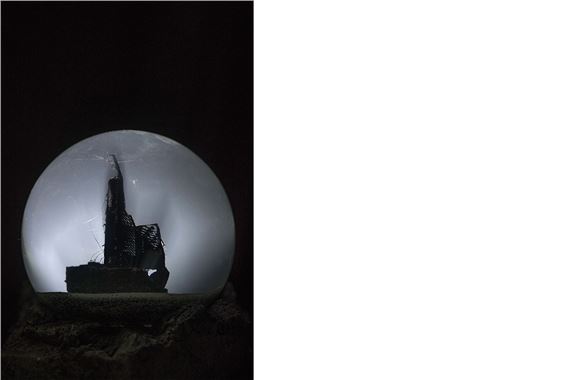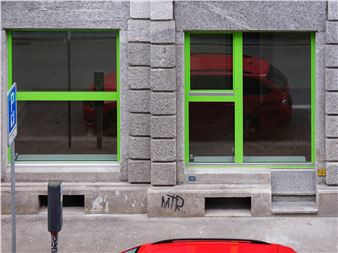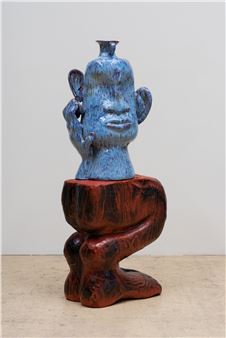Gabriel Valansi: Atlantis
Gabriel ValansiвҖҷs artistic practice highlights how visual memory is entangled with the degradation of information. His work poses fundamental questions: What is truly forming within us? What are we really seeing? What are we actually perceiving?
His project Atlantis emerges as a continuation of these inquiries, developed alongside the rise of 3D printing and the everyday possibility of generating objects. Rather than focusing on the finished objects themselves, Valansi directs his attention to the errors of the machines. He consistently works within these вҖңerror zones,вҖқ forcing glitches, bending linear programs until the systems crash, and exploring the unintended results that appear when tools are used against their intended purposes.
The myth of Atlantis became a conceptual anchor for this exploration. Inspired by both ancient Platonic accounts and later theories that cast the Atlanteans as an advanced technological civilization destroyed by its own uncontrollable development, Valansi connects this legend to contemporary anxieties about technological singularity. As futurist Vernor Vinge predicted in the 1960s, this thresholdвҖ”where technology becomes so complex that only other technologies can manage itвҖ”may arrive around 2030, a moment now uncomfortably nearby.
Through the distorted fragments of 3D prints, Valansi imagines impossible architectures of the lost city: structures born from glitches, deformities, and anomalies. In this way, Atlantis evokes a civilization overwhelmed by its own creations, while also reflecting our present reality of algorithmically generated images, systems that perpetuate misinformation, and technologies that evolve beyond human oversight.
ValansiвҖҷs Atlantis ultimately challenges us to confront urgent questions about our relationship with technology, perception, and the risks of unchecked innovationвҖ”questions that, if left unanswered, may lead humanity toward an Atlantis-like fate.
IN SEARCH OF ATLANTIS
For decadesвҖ”centuries, evenвҖ”whether inspired by noble intentions or by the most dubious motives, theosophists and occultists, mystics and pseudo-scientists, charlatans and conspiracy theorists alike have fueled popular fascination with Atlantis: a supposed ancient yet highly advanced civilization, tragically lost to the depths of the sea.
At least one element of that legend resonates powerfully today: the Atlanteans are said to have perished through the unchecked expansion of their own technology.
After a long succession of frustrated attemptsвҖ”near the Bosphorus, off the Strait of Gibraltar, by the Azores, or in the Gulf of LaconiaвҖ”the ruins of AtlantisвҖҷs prodigious constructions have, at last, been revealed.
They were not hidden on the seabed, nor at the ocean floor, nor beneath the waves of the Mediterranean.
Instead, the traces of this archetype of the вҖңlost cityвҖқ have surfaced within the fissures of a contemporary process of trans-codification: in the residual glitches of three-dimensional printingвҖ”caused by electronic errors or micro mechanical failuresвҖ”Gabriel Valansi has unearthed Atlantis.
вҖңThe original matrix of computer science,вҖқ writes Гүric Sadin, вҖңmaintains a furtive connection with the Kabbalah, which sees in texts or phenomena the possibility of being entirely transcribed вҖ” or вҖҳtrans-codifiedвҖҷ вҖ” into numbers, to unravel them or reorder them according to their fundamental components.вҖқ
Undeniably, something mystical and enigmatic also haunts the cracks of this contemporary Gematria, which mathematically transposes objects to command their reproduction.
Each fault in transduction gives rise to strange, spectral forms вҖ” fragments of an impossible culture, ominous yet strikingly beautiful.

Recommended for you
Gabriel ValansiвҖҷs artistic practice highlights how visual memory is entangled with the degradation of information. His work poses fundamental questions: What is truly forming within us? What are we really seeing? What are we actually perceiving?
His project Atlantis emerges as a continuation of these inquiries, developed alongside the rise of 3D printing and the everyday possibility of generating objects. Rather than focusing on the finished objects themselves, Valansi directs his attention to the errors of the machines. He consistently works within these вҖңerror zones,вҖқ forcing glitches, bending linear programs until the systems crash, and exploring the unintended results that appear when tools are used against their intended purposes.
The myth of Atlantis became a conceptual anchor for this exploration. Inspired by both ancient Platonic accounts and later theories that cast the Atlanteans as an advanced technological civilization destroyed by its own uncontrollable development, Valansi connects this legend to contemporary anxieties about technological singularity. As futurist Vernor Vinge predicted in the 1960s, this thresholdвҖ”where technology becomes so complex that only other technologies can manage itвҖ”may arrive around 2030, a moment now uncomfortably nearby.
Through the distorted fragments of 3D prints, Valansi imagines impossible architectures of the lost city: structures born from glitches, deformities, and anomalies. In this way, Atlantis evokes a civilization overwhelmed by its own creations, while also reflecting our present reality of algorithmically generated images, systems that perpetuate misinformation, and technologies that evolve beyond human oversight.
ValansiвҖҷs Atlantis ultimately challenges us to confront urgent questions about our relationship with technology, perception, and the risks of unchecked innovationвҖ”questions that, if left unanswered, may lead humanity toward an Atlantis-like fate.
IN SEARCH OF ATLANTIS
For decadesвҖ”centuries, evenвҖ”whether inspired by noble intentions or by the most dubious motives, theosophists and occultists, mystics and pseudo-scientists, charlatans and conspiracy theorists alike have fueled popular fascination with Atlantis: a supposed ancient yet highly advanced civilization, tragically lost to the depths of the sea.
At least one element of that legend resonates powerfully today: the Atlanteans are said to have perished through the unchecked expansion of their own technology.
After a long succession of frustrated attemptsвҖ”near the Bosphorus, off the Strait of Gibraltar, by the Azores, or in the Gulf of LaconiaвҖ”the ruins of AtlantisвҖҷs prodigious constructions have, at last, been revealed.
They were not hidden on the seabed, nor at the ocean floor, nor beneath the waves of the Mediterranean.
Instead, the traces of this archetype of the вҖңlost cityвҖқ have surfaced within the fissures of a contemporary process of trans-codification: in the residual glitches of three-dimensional printingвҖ”caused by electronic errors or micro mechanical failuresвҖ”Gabriel Valansi has unearthed Atlantis.
вҖңThe original matrix of computer science,вҖқ writes Гүric Sadin, вҖңmaintains a furtive connection with the Kabbalah, which sees in texts or phenomena the possibility of being entirely transcribed вҖ” or вҖҳtrans-codifiedвҖҷ вҖ” into numbers, to unravel them or reorder them according to their fundamental components.вҖқ
Undeniably, something mystical and enigmatic also haunts the cracks of this contemporary Gematria, which mathematically transposes objects to command their reproduction.
Each fault in transduction gives rise to strange, spectral forms вҖ” fragments of an impossible culture, ominous yet strikingly beautiful.

 ARTISTS
ARTISTS
















